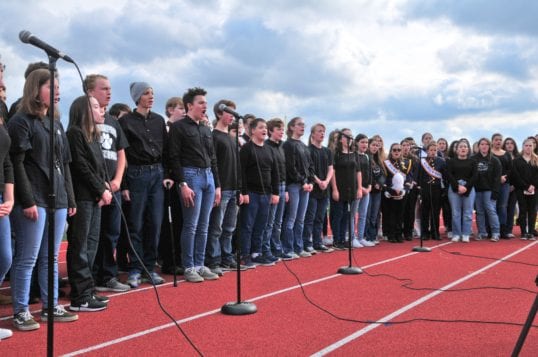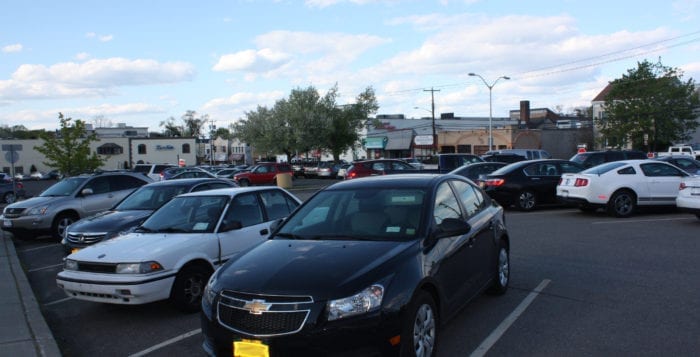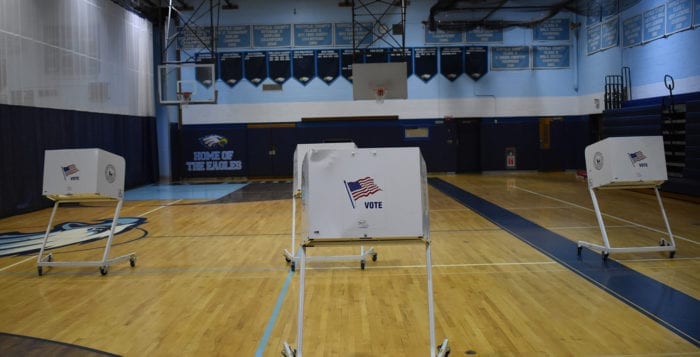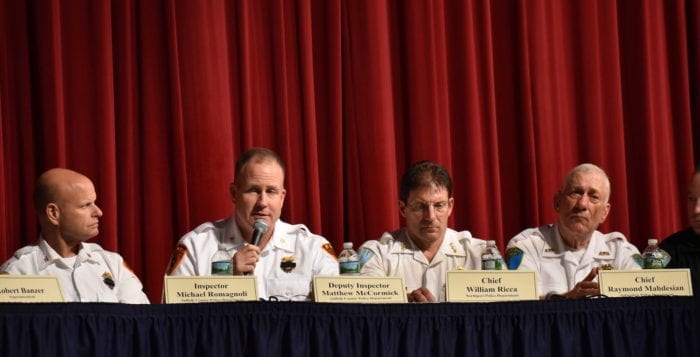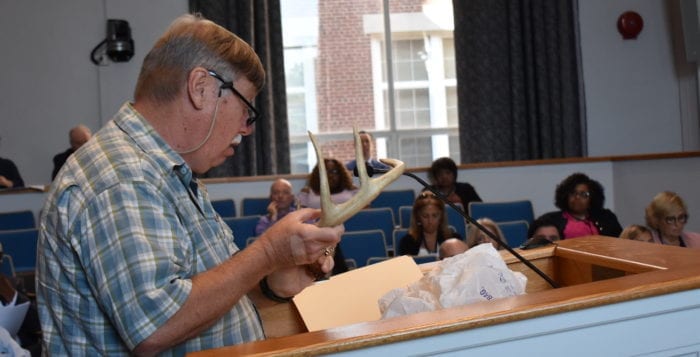The Northport-East Northport school district has been taking it slow and steady in considering hiring armed guards for its school buildings. The board of education is in the process of soliciting professional opinions from local police and security advisers to determine the path forward for its schools.
About 70 people filed into a public meeting hosted by the school board Oct. 11, which included members of the Suffolk County Police Department, Northport Police Department, Asharoken Police Department, the school district’s retained attorneys from Ingerman Smith LLP, the district’s insurance provider New York Schools Insurance Reciprocal and the district’s security adviser to answer the board and the community questions about the potential impact of hiring armed security guards.
“There is a lot of interest about this throughout the county,” said Suffolk County Police Department Inspector Michael Romagnoli, the commanding officer of the department. “All are debating this topic at similar levels.”
The board hosted a previous meeting March 1 where the community came out in droves to voice support for the district hiring armed guards, though when asked whether he would want armed guards Leonard Devlin, the district’s security consultant, said he would prefer not to.
“It would be my recommendation to not have armed guards in our schools.’
— Leonard Devlin
“It would be my recommendation to not have armed guards in our schools,” Devlin said. “If we were to have armed security personnel, the officer would only respond if there was an active shooter, not if there was a physical confrontation with a student, teacher or of any nature.”
The district said it has upgraded multiple security measures since the start of the year. Devlin said the district hired 12 new unarmed guards, which now totals 30 guards who patrol campus grounds during the school day from 7 a.m. to 3 p.m. The district also purchased six new security vehicles to complement an existing six, which should arrive in about a month.
Security vestibules are already installed or close to being installed for all schools except Bellerose Avenue Elementary, Ocean Avenue Elementary and Northport Middle School, which the security consultant said would be completed in the future as part of the district’s ongoing $40 million capital bond project. The district said it has installed 30 new cameras this year for a new total of 400 throughout the buildings, though these are monitored sparingly throughout the day and in the late-night hours, Devlin said.
One of the biggest questions raised surrounding the need for armed guards in schools is whether local police response time is fast enough to deal with an armed assailant. Romagnoli said their response time for local cars was four to five minutes, while Northport Police Chief William Ricca said their response time was three to four minutes. The inspector said that a school shooting comes in as a Priority 0, the highest priority, the same as if a call came in that an officer was shot. Romagnoli said since the 1999 Columbine High School massacre in Colorado cops are trained to enter an active shooter situation immediately upon arriving at the scene.
“Our involvement in the schools has increased tremendously within the last five years, our number of school incidents in the 2nd Precinct has gone up 50 percent, and the officers have more familiarity with the schools just from their daily patrols,” SCPD Deputy Inspector Matthew McCormick said.
“Columbine was a long time ago, and now the police are pulled in so many different directions with what to prioritize around Long Island.”
— David Stein
Board Vice President David Stein said he was concerned it was not possible for every member of every police department to be intimate with the district’s six separate school facilities.
“Columbine was a long time ago, and now the police are pulled in so many different directions with what to prioritize around Long Island,” Stein said.
Romagnoli said the 2nd Precinct has one school resource officer assigned to cover all school districts in the area, not accounting for the other police officers who sometimes take up SRO duties part time on top of their normal police work. The SRO is responsible for being a liaison from the district to the police and for safety and crime prevention in schools.
While some members of the board questioned if guards should be on the premises for longer than regular school hours, to protect kids in after-school activities and sports, but Devlin said it came down to money. He estimated armed guards working at approximately $15 an hour for an eight-hour day would cost the district $208,200, if one guard for each of the district’s nine school campuses were allotted. Though Devlin added if the district wants total coverage for the day, including an hour break for each guard, it would have to hire another three to cover them on their breaks, adding up to just under $400,000.
Police representatives admitted armed guards and police arriving on scene of an emergency could present other problems. There is potential for a “blue on blue” situation, where two armed responders potentially confront each other. Current school security recently changed their uniform to be a bright gold color, but there is no consistency in the uniform between armed presences in other schools. Romagnoli said because of these inconsistencies it’s important the district keep a clear line of communication to the police departments and for dispatch to know of the armed presence inside the school.
“We routinely drill in active shooter response and deliberately build those scenarios into our drills, and I can say we do have a discharge from one officer to another officer. We would rather that happen in training than out in the world.”
— Michael Romagnoli
“Our protocol is the uniformed officer responding is in charge,” Romagnoli said. “We routinely drill in active shooter response and deliberately build those scenarios into our drills, and I can say we do have a discharge from one officer to another officer. We would rather that happen in training than out in the world.”
Those on the panel representing the district’s liability concerns said insurance would cover the district in most cases should an armed guard be present. John Peppard, the senior vice president of NYSIR, the school’s insurance handler, said the only time the school might have a problem is if the guards, as school employees, went rogue in some way.
Local resident Denise Schwartz said despite assurances from local police departments promising prioritized response, the comments made by the panel members did not instill much optimism, especially considering the presence of just one SCPD SRO and the little time the district monitors the security cameras.
“Several things they said made me feel even less safe,” Swartz said.
For Northport resident Tammie Topel, who said she’s still on the fence about hiring armed guards, the meeting did little to eliminate the catch 22 inherent in the decision.
“I think that it opens up whether you do, or you don’t, you’re either not indemnified, or there’s going to be a lawsuit, or there might be an accidental shooting,” Topel said. “There’s 400 cameras that are not being monitored at all times, so what’s the sense of wasting that money on cameras … they should be monitored if that’s what we’re going to be using them for.”
The district will be hosting another workshop Nov. 1 where it will discuss the emotional and psychological impact of having armed guards in schools. On Nov. 8, the board will discuss whether it will put the item on the agenda for vote at a subsequent meeting.




 Along with Laimo and Hartmann, the works of Olivia Belluomo, Brooke Blumberg, Sage Boiko, Grace Burkart, Giavanna Castro, Ziqian Chen, Maxwell DeFalco, Alysse Fazal, Gloria Gang, Rachel Taylor Goldsmith, Elizabeth Gordin, Jenna Hart, Morgan Hlaing, Jiayi Huo, Evelyn Johnson, Aya Karimealaoui, Evgenia Kennedy, Siyu Lei, Juliette Liberatoscioli, Angelina Lomangino, Jessica Lyle, Sara Madsen, Chase McGill, Madalyn Metzger, Frida Misko, Benjamin Pollard, Sophia Polizzi, Dylan Roca, Matthew Rubenfeld, Jessica Rush, Mehr Sharma, Martina Simone, Juliah Triana, Leia Ulrich, Anna Vig, Emily Villavicencio,
Along with Laimo and Hartmann, the works of Olivia Belluomo, Brooke Blumberg, Sage Boiko, Grace Burkart, Giavanna Castro, Ziqian Chen, Maxwell DeFalco, Alysse Fazal, Gloria Gang, Rachel Taylor Goldsmith, Elizabeth Gordin, Jenna Hart, Morgan Hlaing, Jiayi Huo, Evelyn Johnson, Aya Karimealaoui, Evgenia Kennedy, Siyu Lei, Juliette Liberatoscioli, Angelina Lomangino, Jessica Lyle, Sara Madsen, Chase McGill, Madalyn Metzger, Frida Misko, Benjamin Pollard, Sophia Polizzi, Dylan Roca, Matthew Rubenfeld, Jessica Rush, Mehr Sharma, Martina Simone, Juliah Triana, Leia Ulrich, Anna Vig, Emily Villavicencio,





